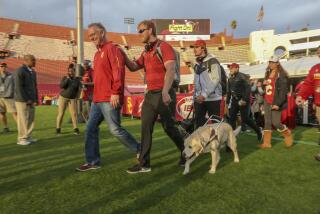All Good Dogs Go to Training School : Canines: Young handlers prepare guide dogs for blind people through a Southland 4-H program.
POMONA — Jezebel goes to class at Pomona Catholic High School mainly on Fridays, never does homework, can’t read and doesn’t know any algebra.
But she was named an honorary sophomore at a school assembly last week, and her education has progressed nicely--particularly for a 1-year-old.
Jezebel is a guide dog in training. Her education has more to do with negotiating street crossings through traffic than deriving square roots. Yet, what she learns at Pomona Catholic will be instrumental to the golden retriever’s future.
If Jezebel is going be a guide dog, she will have to respond to any situation calmly and obediently. Trainer Jennifer Conrad, 15, of Alta Loma takes the dog on campus to become accustomed to the unexpected, the unusual.
“I take her to school and that sometimes gets to be a pain because other people don’t understand why a dog is at school,” Jennifer said. “They make weird comments like ‘Stupid dog’ and ‘Your dog needs a bath.’ ”
Mastering a campus setting is just part of Jezebel’s education, said Esther Acha, a San Bernardino County 4-H leader who helps teen-agers train guide dogs.
“The kids try to do as many things with their dog that a blind person would do later on,” said Acha, who is blind. “They take them out walking, through automatic doors, into grocery stores, into a restaurant, to baseball games.”
Acha’s first guide dog helped the retired transcriber complete her own schooling. “When I first went to college, I had a cane,” she said. “But a cane doesn’t take you around obstacles and open manholes.”
The animals aren’t expected to memorize routes; the blind person must know how to get places. Because dogs can’t distinguish between green and red, Acha said, a blind person must know when to cross streets by listening to the flow of traffic. But a well-trained dog can watch for cars and will disobey commands that endanger its blind master.
The dogs must be unflappable, attentive and obey hand signals as well as verbal commands. “You have to put all your confidence in the dog and realize it’s there for your eyes and will do things for you that you can’t do for yourself,” Acha said.
Blind people get the dogs free but must take a 28-day seminar on using the dogs properly. Raising and preparing a single guide dog costs close to $20,000, said Keith Tomlinson, Southern California field representative of Guide Dogs for the Blind of San Rafael.
Charitable contributions allow Guide Dogs, the largest of three such institutions in California, to prepare about 230 dogs a year, Tomlinson said. The waiting list for a dog is six to eight months. “There’s an ever-growing demand,” he said.
Currently, Guide Dogs has 750 pups housed with volunteer trainers, about 160 of them in Southern California. Many of their dogs, like Jezebel, are placed in homes through 4-H groups.
Jennifer joined 4-H largely to participate in the guide-dog training, which has long been an important focus of the San Bernardino County chapter. Jezebel is her first dog to go this far in the program; she had started to raise another dog that turned out to be too aggressive.
Before Jezebel can fill in for a blind person’s eyes, Jennifer will use her own eyes, heart and mind to hone her dog’s skills.
“She’s gotten an appreciation of what it’s like to be a parent,” said Jack Conrad, Jennifer’s father. “She has to do a certain amount of things she doesn’t want to. It’s taught her that responsibility is more than a word.”
Jezebel has become a nearly constant companion for Jennifer, accompanying her to Dodger and Angel baseball games, church every Sunday, a miniature golf outing, a trip to Utah and a Chinatown excursion with more than a dozen other guide puppies and their teen-age trainers.
A rough experience was attending the Los Angeles Marathon a month after Jennifer received Jezebel. It was one of Jennifer’s first experiences picking up after a puppy in a crowd.
The trainers travel with plastic bags they call mess kits. When fully trained, a dog will put off nature’s call till the command, “Do your business.” Blind recipients of the dogs also are expected to clean up after their pets.
Jezebel, now 55 pounds, sometimes acts more like a puppy than a guide dog. She recently made off with the lunch of Jennifer’s grandmother, and once gnawed a hole in the pants of Jennifer’s sister.
Jezebel also has a tendency to get car sick, something Jennifer is trying to help the dog to overcome. “You just have to make sure she knows that riding in a car is fun and stuff . . . or she won’t qualify.”
Fully half of guide puppies don’t make the grade, Tomlinson said. The stakes are too high to risk using an erratic dog.
“I fell off a curb because he was avoiding a sprinkler,” Acha said of one guide dog she had to return. Because of the dog’s squeamishness, Acha ended up in a walking cast twice.
Most dogs that don’t make it, or who are retired, become sought-after pets because they are so well-trained. Some blind people keep their retired dogs. Volunteer trainers get the first crack at canines that don’t become guide dogs.
Keeping Jezebel, however, isn’t the point, said Jennifer, a B student who will try out for cheerleading if it doesn’t take her away from guide-dog training. “She realizes she’s just not a normal dog. Other dogs are allowed to jump on the bed and do other things she’s not allowed to . . . . I work with her every day on obedience.”
When Jezebel returns to Guide Dogs for final training in May, “I’ll probably be crying,” Jennifer admitted. “When I go to school and she doesn’t come with me, she sits by the gate till she can’t see me any more.” The dog’s ears perk up just at the mention of Jennifer’s name.
“It’s remarkable to me to see those kids lovingly give up their dogs,” Jack Conrad said. “That’s the profound aspect, to make that sacrifice for somebody else.”
THE LIFE OF A GUIDE DOG Age: 0Event in Guide Dog’s Life: Prospect born in breeding program. Age: 8-12 weeks Event in Guide Dog’s Life: Puppies go to volunteer trainers, many of them teen-agers in 4-H groups. Age: 14-18 months Event in Guide Dog’s Life: Dogs return to professional trainers for four to six months of intensive work. Age: After training Event in Guide Dog’s Life: Dogs are assessed for suitability as guide dogs. About half will be found unsuitable. Some of the most promising will be reserved for breeding. Age: 23 months Event in Guide Dog’s Life: Blind owner begins monthlong training with dog. Age: 2 years Event in Guide Dog’s Life: Guide dog goes home with blind owner. Age: 10 years Event in Guide Dog’s Life: Approximate retirement age for dog, who will become a pet, possibly of the blind person or the volunteer trainer. Source: Keith Tomlinson, Guide Dogs For The Blind Inc.
More to Read
Sign up for Essential California
The most important California stories and recommendations in your inbox every morning.
You may occasionally receive promotional content from the Los Angeles Times.











